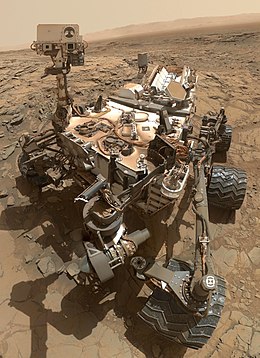
Back Curiosity-verkenningstuig Afrikaans Curiosity AN كيوريوسيتي روفر Arabic Curiosity AST কিউরিওসিটি (মঙ্গলগ্রহ বিচরণ যান) Bengali/Bangla Curiosity Catalan کیوریاستی CKB Curiosity Danish Curiosity (Rover) German Curiosity Greek
| Curiosity | |
|---|---|
| Part of Mars Science Laboratory | |
 Self-portrait by Curiosity at the foot of Mount Sharp in October 2015 | |
| Type | Mars rover |
| Owner | NASA |
| Manufacturer | Jet Propulsion Laboratory |
| Specifications | |
| Dimensions | 2.9 m × 2.7 m × 2.2 m (9 ft 6 in × 8 ft 10 in × 7 ft 3 in) |
| Dry mass | 899 kilograms (1,982 lb) |
| Communication | |
| Power | MMRTG: ~100 W (0.13 hp) |
| Rocket | Atlas V 541 |
| Instruments | |
| History | |
| Launched |
|
| Deployed |
|
| Location | Gale crater, Mars |
| Traveled | 32.39 km (20.13 mi) on Mars as of 19 September 2024[update][1] |
| NASA Mars rovers | |
Curiosity is a car-sized Mars rover exploring Gale crater and Mount Sharp on Mars as part of NASA's Mars Science Laboratory (MSL) mission.[2] Curiosity was launched from Cape Canaveral (CCAFS) on November 26, 2011, at 15:02:00 UTC and landed on Aeolis Palus inside Gale crater on Mars on August 6, 2012, 05:17:57 UTC.[3][4][5] The Bradbury Landing site was less than 2.4 km (1.5 mi) from the center of the rover's touchdown target after a 560 million km (350 million mi) journey.[6][7]
Mission goals include an investigation of the Martian climate and geology, assessment of whether the selected field site inside Gale has ever offered environmental conditions favorable for microbial life (including investigation of the role of water), and planetary habitability studies in preparation for human exploration.[8][9]
In December 2012, Curiosity's two-year mission was extended indefinitely,[10] and on August 5, 2017, NASA celebrated the fifth anniversary of the Curiosity rover landing.[11][12] On August 6, 2022, a detailed overview of accomplishments by the Curiosity rover for the last ten years was reported.[13] The rover is still operational, and as of 23 November 2024, Curiosity has been active on Mars for 4372 sols (4492 total days; 12 years, 109 days) since its landing (see current status).
The NASA/JPL Mars Science Laboratory/Curiosity Project Team was awarded the 2012 Robert J. Collier Trophy by the National Aeronautic Association "In recognition of the extraordinary achievements of successfully landing Curiosity on Mars, advancing the nation's technological and engineering capabilities, and significantly improving humanity's understanding of ancient Martian habitable environments."[14] Curiosity's rover design serves as the basis for NASA's 2021 Perseverance mission, which carries different scientific instruments.
- ^ "Where Is Curiosity?". science.nasa.gov. NASA. Retrieved September 19, 2024.
 This article incorporates text from this source, which is in the public domain.
This article incorporates text from this source, which is in the public domain.
- ^ Cite error: The named reference
NASA-Curiositywas invoked but never defined (see the help page). - ^ Cite error: The named reference
Abilleira2013was invoked but never defined (see the help page). - ^ Cite error: The named reference
bbc20120808was invoked but never defined (see the help page). - ^ Cite error: The named reference
youtube1was invoked but never defined (see the help page). - ^ Cite error: The named reference
NASA-20120822was invoked but never defined (see the help page). - ^ Cite error: The named reference
autogenerated1was invoked but never defined (see the help page). - ^ Cite error: The named reference
overviewwas invoked but never defined (see the help page). - ^ Cite error: The named reference
goalswas invoked but never defined (see the help page). - ^ Cite error: The named reference
3news.nzwas invoked but never defined (see the help page). - ^ Cite error: The named reference
NASA-20170802was invoked but never defined (see the help page). - ^ Cite error: The named reference
SP-20170805was invoked but never defined (see the help page). - ^ Chang, Ailsa (August 6, 2022). "What a decade of Curiosity has taught us about life on Mars". NPR. Retrieved August 6, 2022.
- ^ Cite error: The named reference
NAA-20130312was invoked but never defined (see the help page).